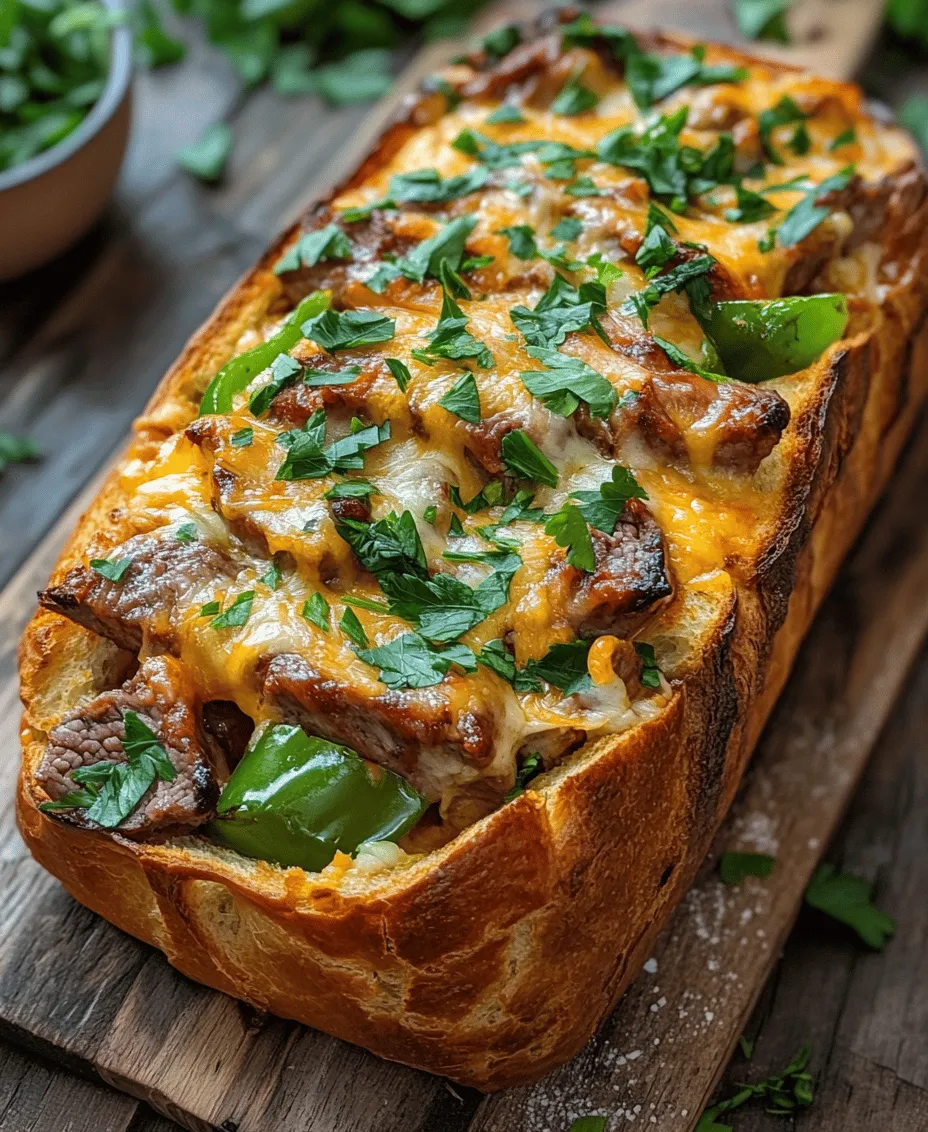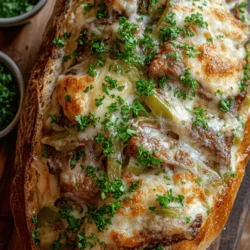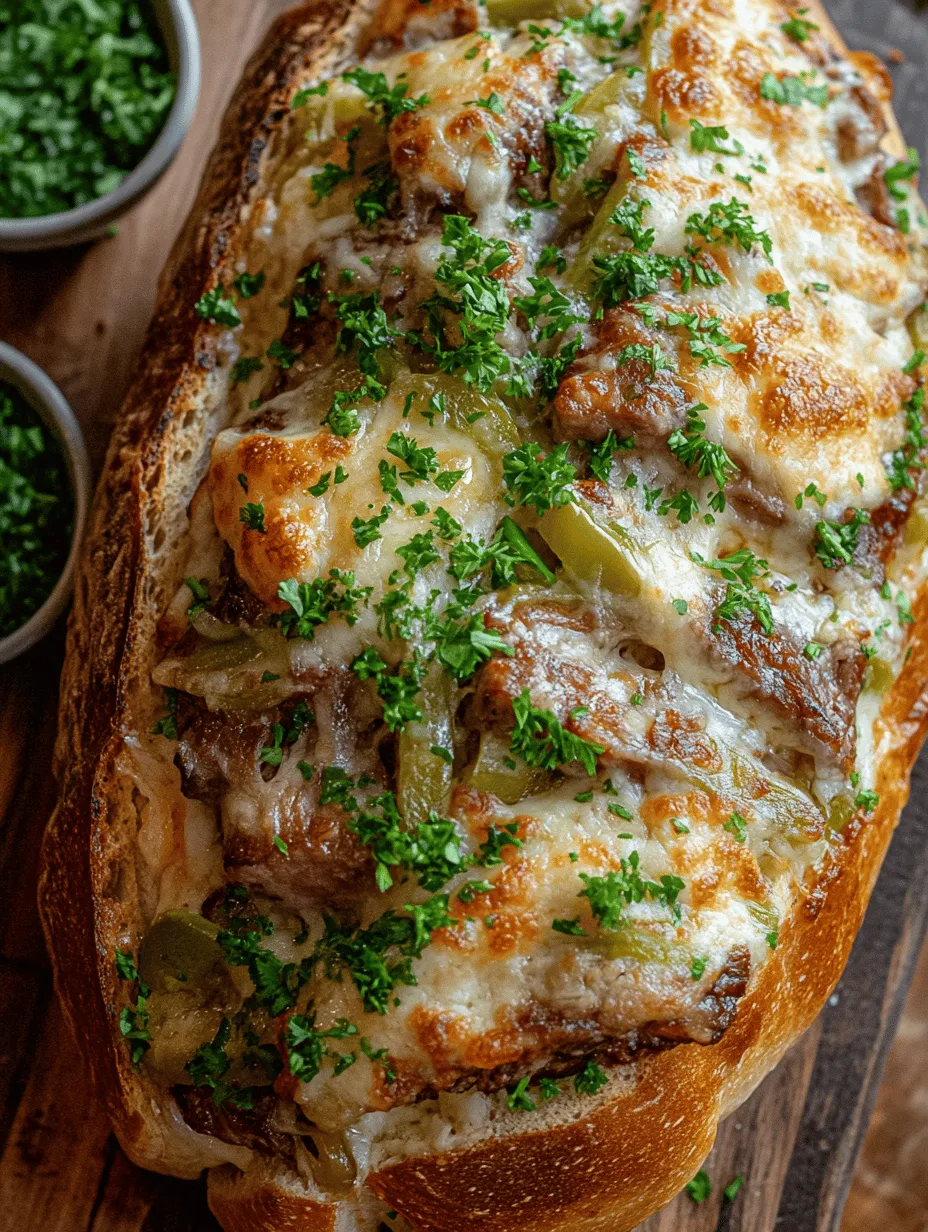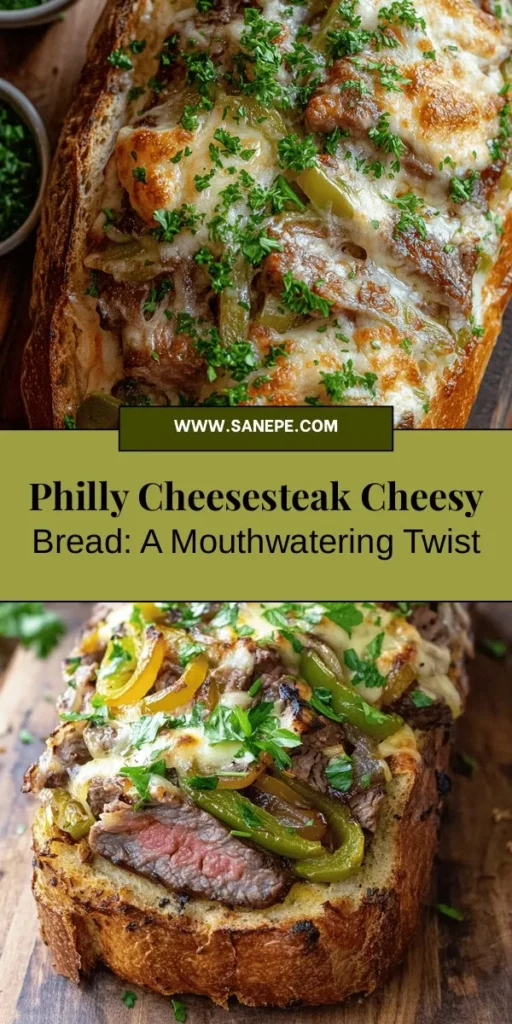Introduction
Philly Cheesesteak Cheesy Bread is a mouthwatering creation that brings together two iconic comfort foods: the classic Philly cheesesteak and the beloved cheesy garlic bread. This dish is a true crowd-pleaser, making it an ideal choice for gatherings, game days, or simply a cozy night in. With its rich flavor profile, this cheesy bread features tender ribeye steak, sautéed vegetables, and a generous blend of provolone and mozzarella cheeses, all encased in a crispy loaf of Italian or French bread. This combination not only satisfies your taste buds but proves to be incredibly easy to whip up, making it a favorite among both seasoned cooks and kitchen novices alike. In this article, we’ll delve into the origins of the Philly cheesesteak, the unique twist of this cheesy bread version, and provide a step-by-step guide to creating this delightful treat.
The Origins of the Philly Cheesesteak
The Philly cheesesteak is more than just a sandwich; it’s a culinary icon with deep roots in American history. Born in the streets of Philadelphia in the early 20th century, the cheesesteak originated from a simple hot dog vendor named Pat Olivieri. Legend has it that Pat decided to grill some beef on his hot dog stand one day. A passing cab driver caught a whiff of the delicious aroma and asked for a sandwich made with the grilled meat. The sandwich quickly became a hit, and Pat Olivieri soon opened his own restaurant to serve his creation.
Over the decades, the Philly cheesesteak evolved into a staple of Philadelphia cuisine, often characterized by its thinly sliced ribeye steak, sautéed onions, and a choice of cheese, typically Cheez Whiz, provolone, or American. The sandwich reflects the city’s rich history and diverse immigrant influences, combining different flavors and cooking techniques.
As the cheesesteak gained popularity, variations began to emerge across the United States. From the addition of mushrooms and peppers to the use of alternative meats, chefs and home cooks alike have put their own spin on this classic. Today, the cheesesteak can be found in countless forms, making it a beloved dish far beyond its Philadelphia roots.
Understanding the Ingredients
To create the best Philly Cheesesteak Cheesy Bread, the quality of ingredients plays a crucial role. Here’s a breakdown of the main components that will take your dish from ordinary to extraordinary.
Ribeye Steak
The star of this recipe is undoubtedly the ribeye steak. Known for its marbled fat and rich flavor, ribeye is perfect for achieving that tender and juicy texture that is essential in a cheesesteak. The fat renders during cooking, infusing the meat with flavor and ensuring it remains moist. Opting for thinly sliced ribeye will help it cook quickly and evenly, making it an ideal choice for this dish.
Fresh Vegetables: Onions and Bell Peppers
Onions and bell peppers are traditional accompaniments to a classic cheesesteak. When sautéed, these vegetables provide a sweet and savory flavor that complements the richness of the steak. Onions caramelize beautifully when cooked, adding depth to the overall flavor of the dish. Meanwhile, bell peppers introduce a slight crunch and vibrant color, enhancing both the visual appeal and taste.
Provolone and Mozzarella Cheese
Cheese is an integral part of any cheesesteak, and in this cheesy bread recipe, we use a combination of provolone and mozzarella. Provolone adds a sharp, tangy flavor that perfectly balances the richness of the steak, while mozzarella offers that gooey, melty texture we all crave. Together, they create a deliciously cheesy filling that oozes out of the bread with every bite.
Choosing the Right Bread: Italian vs. French
The choice of bread is essential for achieving the perfect chewy yet crispy texture. Both Italian and French bread are excellent options for this recipe. Italian bread tends to be slightly denser, which can hold up better to the hearty filling, while French bread offers a light and airy interior with a crisp crust. Whichever you choose, make sure it is fresh and has a sturdy structure to support the filling.
Optional Ingredient Variations
While the classic version of this recipe is already delicious, there are plenty of ways to personalize it. For those looking for a different flavor profile, consider adding sautéed mushrooms, jalapeños for a spicy kick, or even spinach for a nutritious twist.
Additionally, if you’re not a fan of ribeye, you can substitute it with other meats like chicken or turkey for a lighter option. There are also vegetarian alternatives such as sautéed portobello mushrooms or a combination of your favorite vegetables that can replace the meat while still delivering a satisfying meal.
Different Cheese Blends for Flavor Variations
Don’t be afraid to experiment with different cheese blends! While provolone and mozzarella are classics, you could try adding cheddar for a sharper taste or gouda for a slightly smoky flavor. Mixing various cheeses can elevate your cheesy bread and create new flavor combinations that cater to your personal preferences.
Preparing the Cheesy Bread
Now that we understand the importance of each ingredient, let’s dive into the preparation process for the cheesy bread itself. The bread serves as the vessel for all the delicious fillings, so getting it right is crucial.
Step-by-Step Guide to Preparing the Bread
1. Choose Your Bread: Start with a fresh loaf of either Italian or French bread. Look for a loaf that is crispy on the outside but soft on the inside.
2. Preheat the Oven: Preheat your oven to 375°F (190°C). This temperature will ensure that your cheesy bread gets golden and crispy without burning.
3. Hollow Out the Bread: Using a serrated knife, carefully slice the loaf in half lengthwise. You want to create a boat-like shape to hold the filling. Next, take a spoon or your hands and gently hollow out the soft interior of the bread. Leave a thin layer of bread on the sides and bottom to prevent the filling from leaking out during baking. This step is crucial for optimal filling and to ensure your bread maintains its structure throughout the cooking process.
4. Prepare the Baking Sheet: Line a baking sheet with parchment paper or aluminum foil to catch any drips and make cleanup easier. Place your hollowed-out bread halves cut-side up on the baking sheet.
Importance of Hollowing Out the Bread for Optimal Filling
Hollowing out the bread is not just about aesthetics; it serves a functional purpose. By removing excess bread, you create more space for the delicious filling, allowing for a greater ratio of steak and cheese in each bite. This technique also helps prevent the bread from becoming soggy, as the filling will have room to breathe and stay intact during baking.
Tips for Selecting the Right Baking Sheet
When it comes to baking your cheesy bread, the right baking sheet can make all the difference. Opt for a sturdy, rimmed baking sheet to catch any melted cheese or juices that may escape during cooking. Using parchment paper or foil will not only facilitate easy removal of the bread but also aid in achieving that perfect golden crust.
Cooking the Vegetables
With the bread prepped, it’s time to sauté the vegetables, a step that enhances their flavor and texture significantly.
Techniques for Sautéing Vegetables to Enhance Flavor
1. Heat the Pan: Begin by heating a large skillet over medium-high heat. Adding a splash of olive oil or a pat of butter will help prevent sticking and add flavor.
2. Add Onions First: Start by adding sliced onions to the pan. Sauté them for about 2-3 minutes until they start to become translucent. This step allows the onions to release their natural sugars, which will sweeten and deepen their flavor.
3. Incorporate the Bell Peppers: Once the onions have softened, add the sliced bell peppers. Stir occasionally, cooking for an additional 3-4 minutes until the peppers are tender but still maintain a slight crunch.
4. Season to Taste: Season the vegetables with salt, pepper, and any additional spices you desire. A pinch of garlic powder or Italian seasoning can elevate the dish even further.
5. Remove from Heat: Once the vegetables are cooked through, remove them from the heat and set aside. They’ll be combined with the steak and cheese filling later, adding layers of flavor and texture to your cheesy bread.
By following these steps, you’ll create perfectly sautéed vegetables that add depth to your Philly Cheesesteak Cheesy Bread, making each bite an explosion of flavor.
As we continue to explore the preparation of this delectable dish, we will delve into the final steps of combining the ingredients, filling the bread, and baking it to perfection. Stay tuned for the next part of this article!

The Significance of Caramelization and Its Impact on Taste
Caramelization is a crucial process when preparing the vegetable mixture for your Philly Cheesesteak Cheesy Bread. This technique involves cooking onions (and sometimes peppers) at a low temperature over time, which transforms their natural sugars into a rich, sweet flavor. Caramelized onions bring a depth of flavor that balances the savory elements of the steak and cheese, creating a harmonious taste profile.
To achieve perfect caramelization, slice the onions thinly and cook them slowly in a bit of oil or butter. As they cook, stir them occasionally to prevent burning and ensure even cooking. The result will be tender, golden-brown onions that add a delightful sweetness to your cheesy bread.
Recommended Seasoning Tips for Enhancing the Vegetable Mixture
While caramelization enhances the natural sweetness of the vegetables, the right seasonings can elevate their flavor even further. Here are some tips to consider:
1. Salt: Start with a pinch of salt as the onions cook; this helps draw out moisture and encourages caramelization.
2. Pepper: A dash of black pepper adds warmth and balances the sweetness of the onions.
3. Garlic: Mince a clove or two of garlic and add it to the pan in the last few minutes of cooking to avoid burning. Garlic complements the sweetness of the onions perfectly.
4. Herbs: Fresh herbs like thyme or dried Italian seasoning can add aromatic depth. A sprinkle of dried oregano enhances the overall flavor without overwhelming the dish.
5. Red Pepper Flakes: For those who enjoy a bit of heat, adding a pinch of red pepper flakes can provide a nice kick.
Incorporating these seasonings will enhance the vegetable mixture, ensuring that every bite of your Philly Cheesesteak Cheesy Bread is packed with flavor.
Cooking the Steak
Best Practices for Cooking Ribeye Steak
Ribeye steak is a popular choice for Philly cheesesteaks due to its marbled fat, which adds flavor and juiciness. Here are some best practices for cooking ribeye to perfection:
1. Choose the Right Cut: Look for ribeye steaks that have a good amount of marbling. This will ensure a tender and flavorful result.
2. Bring to Room Temperature: Before cooking, let the steak sit at room temperature for about 30 minutes. This helps it cook more evenly.
3. Season Generously: Season the steak with salt and pepper just before cooking. This enhances the natural flavors of the meat.
Understanding Doneness: How to Achieve the Perfect Sear
Cooking steak to the desired doneness can be challenging. For a classic Philly cheesesteak, medium-rare is often preferred, as it yields tender and juicy meat. Here’s how to achieve a perfect sear:
1. Preheat the Pan: Use a cast-iron skillet or heavy-bottomed pan and preheat it over high heat. A hot pan is essential for a good sear.
2. Sear the Steak: Place the steak in the pan and let it cook without moving it for about 2-3 minutes. This allows a crust to form. Flip it and cook for another 2-3 minutes for medium-rare.
3. Check Temperature: Use a meat thermometer to check the internal temperature. Aim for 130-135°F for medium-rare. Remember, the steak will continue to cook slightly after it’s removed from the heat.
The Importance of Worcestershire Sauce for Flavor Enhancement
Worcestershire sauce is a key ingredient that adds umami and depth to the steak. After cooking, drizzle some Worcestershire sauce over the sliced steak to enhance its flavor. This tangy sauce complements both the meat and the cheesy bread, tying all the flavors together beautifully.
Assembling the Philly Cheesesteak Cheesy Bread
Layering Techniques for Balanced Flavor and Texture
Assembling your Philly Cheesesteak Cheesy Bread is an art that requires careful layering to ensure a balanced flavor and texture. Follow these steps:
1. Prepare the Bread: Start with a sturdy bread, such as a hoagie roll or a French baguette. Cut it in half lengthwise and lightly toast the insides to prevent sogginess.
2. Spread a Base Layer: Start with a layer of cheese sauce or cream cheese spread to create a rich base that enhances the cheesy flavor.
3. Add Vegetables: Evenly distribute the caramelized onions and peppers over the cheese base. This ensures that the sweetness of the vegetables is present in every bite.
4. Layer the Steak: Add the sliced ribeye steak on top of the vegetables. Be generous, as the steak is the star of the show.
5. Top with Cheese: Finish with a layer of shredded cheese, such as provolone or mozzarella, to achieve that gooey, melty goodness.
Tips for Evenly Distributing Ingredients for Consistent Taste in Every Bite
For a consistent taste experience in every mouthful, ensure that each layer is evenly distributed. Use a spatula to spread the caramelized vegetables and steak uniformly across the bread. Avoid piling ingredients in one section, as this can lead to bites that are either too cheesy or too meaty.
Baking to Perfection
Oven Temperature and Baking Time Explained
To achieve the perfect cheesy bread, preheat your oven to 375°F (190°C). This temperature allows the cheese to melt thoroughly while giving the bread a chance to crisp up without burning. The baking time typically ranges from 15 to 20 minutes.
How to Know When the Cheesy Bread Is Done
Keep an eye on your bread as it bakes. You’ll know it’s done when the cheese is bubbly and golden brown, and the edges of the bread are crisp. For an extra crispy top, consider broiling for the last couple of minutes, but be sure to watch it closely to prevent burning.
Achieving a Crispy Crust and Gooey Filling
To achieve that desired crispy crust and gooey filling, you can use a combination of techniques:
1. Use a Baking Sheet: Place the assembled cheesy bread on a baking sheet lined with parchment paper. This prevents sticking and helps with even cooking.
2. Cover for the First Half: If the bread starts to brown too quickly, cover it loosely with aluminum foil for the first 10 minutes of baking to allow the cheese to melt without over-browning the bread.
3. Final Broil: As mentioned, a quick broil at the end can help achieve that golden top while ensuring the filling remains gooey.
Serving Suggestions
Presentation Ideas for Serving
When it comes to serving your Philly Cheesesteak Cheesy Bread, presentation can elevate the dining experience. Here are some ideas:
1. Slice and Serve: Cut the cheesy bread into individual portions and serve on a wooden cutting board or platter for a rustic look.
2. Garnish: Add fresh herbs, such as parsley or chives, on top for a pop of color and freshness.
3. Dipping Sauce: Serve with a side of marinara or a creamy dip to enhance the flavors and provide an interactive element.
Pairing Options: What to Serve Alongside Cheesy Bread
Philly Cheesesteak Cheesy Bread is rich and hearty, making it a perfect dish to pair with lighter sides. Consider these options:
1. Salad: A simple green salad with a tangy vinaigrette can balance the richness of the cheesy bread.
2. Fries: Classic French fries or sweet potato fries complement the dish well and add a satisfying crunch.
3. Pickles: Crunchy pickles or pickled vegetables provide a refreshing contrast to the savory cheesy bread.
Creative Ways to Customize Serving Sizes for Gatherings
This recipe is perfect for entertaining. You can easily customize serving sizes by:
1. Mini Versions: Create mini cheesy breads using smaller rolls for bite-sized appetizers.
2. Platter Style: Assemble a large version and cut it into squares for guests to grab and go.
3. Diverse Toppings: Offer a variety of cheeses or toppings for guests to personalize their servings.
Nutritional Information
Overview of Calories and Macronutrient Breakdown per Serving
While the indulgence of Philly Cheesesteak Cheesy Bread is undeniable, being aware of its nutritional content can help you enjoy it mindfully. A typical serving may contain:
– Calories: Approximately 400-500 calories, depending on serving size and cheese used.
– Protein: About 25-30 grams from the ribeye and cheese.
– Fat: Ranges from 20-30 grams, primarily from the steak and cheese.
– Carbohydrates: Approximately 30-40 grams, largely from the bread.
Considerations for Dietary Restrictions (e.g., Gluten-Free Options)
For those with dietary restrictions, consider these alternatives:
1. Gluten-Free Bread: Use gluten-free rolls or bread to make the recipe accessible for those with gluten intolerance.
2. Dairy-Free Cheese: Substitute traditional cheese with a dairy-free alternative to cater to lactose-intolerant individuals or vegans.
3. Lean Meat Choices: For a healthier option, consider using lean cuts of steak or even plant-based meat alternatives.
Conclusion
Philly Cheesesteak Cheesy Bread is more than just a meal; it’s an experience that brings people together. Its rich flavors and comforting textures make it a standout dish that can easily be incorporated into any occasion. By following this comprehensive guide, you can create a delicious and satisfying cheesy bread that pays homage to the classic Philly cheesesteak while adding your personal touch. Whether enjoyed as an appetizer or a main dish, this recipe is sure to become a favorite in your home. With its mouthwatering combination of caramelized vegetables, juicy steak, and gooey cheese, each bite is a celebration of flavor that is bound to impress family and friends alike.


